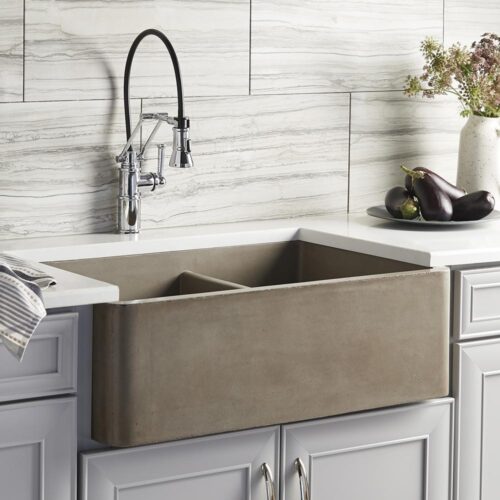If you’re thinking about making or remodeling your kitchen sink area and can’t decide between a single-bowl or a double-bowl sink, then this is the article that will give you a clearer and more informed insight.
A single-bowl sink has only one basin without any dividers in between. They’re usually for kitchens with relatively small counter spaces.
A double-bowl sink is (as its name suggests) a sink with two basins, which is usually separated by a divider in between. Each bowl in this sink is usually about the same size as the other but can come in separate sizes depending on the kind of utensils that you wash or clean.
But which one is more suitable to fit into your kitchen to wash dishes and cooking utensils?
In this article, we’ll compare the pros and cons of each sink and let you know which of these two is most ideal for you in the end.
Pros of Double Bowl Kitchen Sinks
A double bowl sink allows you to:
- Soak dishes in one basin, whereas the other one can be used for washing.
- One side can be used for preparing food, while the other side can be used for washing dirty dishes, or stashing them up for later.
- You can keep heavier dishes from the more delicate ones, such as glassware.
- It helps with easy garbage disposal, with the unit being installed in the smaller sink. This makes the unit easily accessible when the main sink is filled with water or unwashed dishes.
- One side of the sink can be used to keep away dangerous contaminants such as raw chicken while the other side is used for washing raw-meat dishes and utensils or thawing food for dinner.
Cons of Double Bowl Kitchen Sinks
- Double sinks take up too much counter space
- Neither of the sides of a double-bowl sink is large enough to wash bigger dishes like stock pots or cookie sheets.
- A garbage disposal unit can only be installed on one side, whereas the other is likely to have food particles stuck in its pipe.
- One side of the sink might not even get used, which makes this sink no different than its single-bowl counterpart.
Pros of Single-Bowl Sinks
- Single-bowl sinks take up less counter space than their double-bowl counterparts.
- Single-bowl sinks are big enough to wash large pans, pots as well as sheet pans. Even most chefs prefer this sink for washing large items as they cook.
- It’s versatile in that you can put in a temporary dish basin and fill in hot soapy water into it.
- Choosing a single-bowl sink of a larger size is ideal for smaller kitchens as it consumes less counter space.
- It’s suitable to install a garbage disposal unit in a single-bowl sink as it can catch and crush all food debris.
Cons of Single-Bowl Sinks
- Because it has a single basin, delicate dishes are more likely to be broken as they are exposed to bangs and crashes from heavy dishes in the same sink.
- You lack the option to separate dirty dishes from the clean ones.
- You can’t keep dry dishes on one side if you choose to wash dishes with your own hands.
- You are unable to separate dishes contaminated with raw meat juices and frozen meat that is being thawed from other dishes. And if part of the sink gets contaminated, the entire sink ultimately gets contaminated as well.
Which Sink Do You Prefer?
Every kitchen is different for homeowners and restaurants and the way meals are prepared and cleaned up in the end. From the above-mentioned criteria, if you have a small kitchen space, then go for a single-bowl sink. And if you have more space, then a double-bowl sink is advised.


